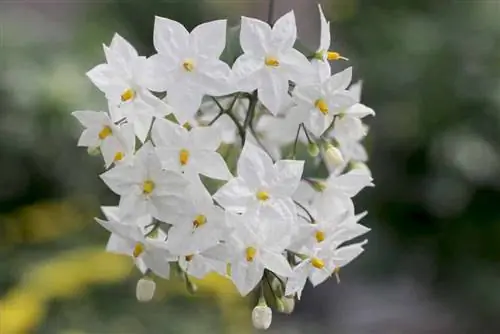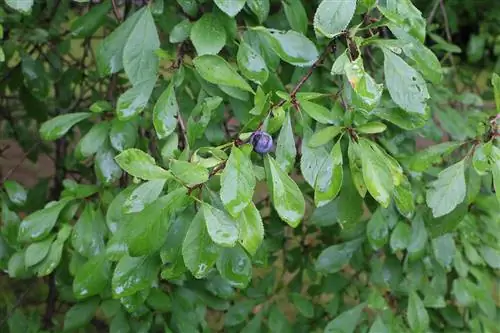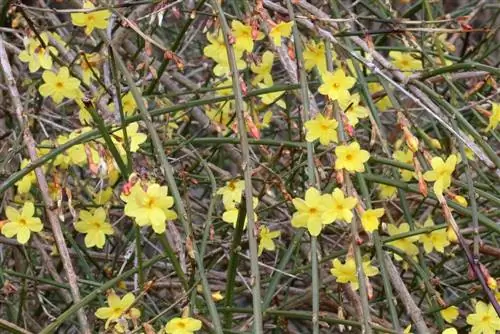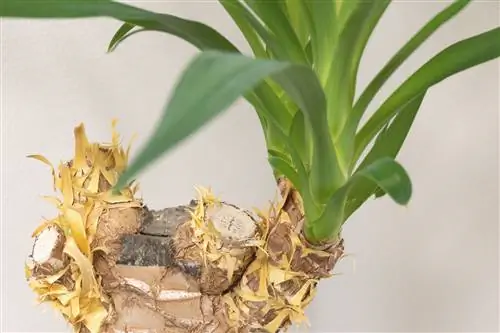- Author admin [email protected].
- Public 2023-12-17 03:39.
- Last modified 2025-01-24 12:45.
The jasmine plant is an attractive and cut-tolerant climbing plant with slender and angular shoots, which should ideally grow on a trellis. In the course of late summer, umbels form on the plant, which contain strongly scented flowers. These flowers of the Jasminum officinale are a bright white color. The jasmine plant grows relatively quickly and therefore needs to be pruned regularly. In addition, pruning is also important for promoting shoot formation and maintaining the abundance of flowers.
Profile
The jasmine plant is a delicate olive tree plant and originally comes from China, but it also occurs wild in Ceylon and India. The fast-growing climbing plant needs regular pruning in order to bloom and grow magnificently for a long time. Due to its origins in warmer regions, Jasminum officinale is not hardy and must be kept in a planter. The following aspects are important in the jasmine plant:
- only suitable for keeping in containers in this country
- only completely green in the summer months
- Flowering period from June to September
- unfolds strongly fragrant and white flowers
- dark and narrow leaves, very similar to the leaves of the olive tree
- Flowers are surrounded by five elongated leaves, which diverge in a star shape
- Petals have a long pistil in their center
- can be placed outside on the balcony, terrace or in the garden in summer
- needs a bright place to overwinter, with temperatures between 5°-10°C
- without a cool resting phase in winter the flowering will stop
- tie long shoots up on a round arch or trellis
- As a potted plant in the room, usually around 0.5-2 meters high
- With a trellis the plant can grow 4-8 meters tall
- Very pruning-tolerant plant, can cope with almost any pruning style
Tip:
Not only the shoots grow back strong and quickly, but also the roots. However, repotting should always be done at a sufficiently large distance from the pruning so that the jasmine plant has enough time to recover.
Time
The right time of pruning is crucial for the development of the jasmine plant, both for the formation of the shoots and for the abundance of the flowers. Ideally, the Jasminum officinale is pruned in early spring so that the plant can develop splendidly at the beginning of summer. The later the pruning is done, the later the climbing plant will bloom. Without pruning, the jasmine plant becomes lazy to bloom because the flowers mainly form on the new shoots. The following aspects should be taken into account when cutting:
- Start cutting early, March is ideal
- cut back shortly before budding
- In regions with mild winters, pruning is possible as early as February
- do not prune during flowering and dormancy
Real or Fake Jasmine?
In order to be able to pay attention to the special features when cutting, you of course have to know exactly which jasmine you actually have in front of you. For a gift e.g. B. it's not always clear:
- The real jasmine or Jasminum officinale belongs to the olive family. It comes from warm areas of China and Japan and now also grows in the Mediterranean, naturally as an olive tree plant. The real jasmine is only green in summer, and its dark and narrow leaves look very similar to those of an olive tree. Its flowers are white with five elongated leaves that diverge in a star shape and have a single long pistil in the center.
- The false jasmine or pipe bush or Philadelphus coronarius, on the other hand, belongs to the hydrangea family, which comes from colder regions and therefore feels at home in German gardens. It has slightly lighter, slightly velvety leaves with jagged edges, and its flowers make it even more clearly distinguishable from real jasmine, which have small and almost round white leaves with many short yellow pistils in the middle.
The two jasmines cannot be distinguished by their scent: the false jasmine was given this name precisely because of its similar scent to Jasminum officinale.
cutting Jasminum officinale
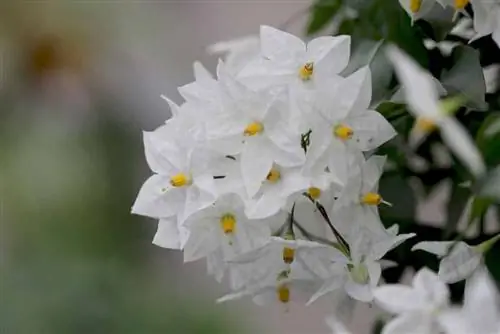
If you don't have a Philadelphus but a real jasmine, it of course needs to be pruned just as much. Although this real jasmine is not particularly closely related to the pipe bush, as will be shown below, it has at least one thing in common with its namesake: it can be pruned willingly and with good success. However, you would have to pay attention to some subtle differences:
- When it comes to real jasmine, you should really take the pruning seriously, because this plant, which we usually keep in a pot, needs some time until it has developed a beautiful, expansive shape.
- Real jasmine can also tolerate rough pruning, but it would be a shame because it takes a long time until the pot looks really decorative again.
- That's why the real jasmine is cut back every year shortly before it sprouts, and really every year, and you should take some time for this cut.
- You have to make sure to thin out this plant as thoroughly as possible, otherwise this jasmine tends to only produce flowers at the outer ends.
- This jasmine needs a new and larger pot every time its roots take up almost the entire pot. The repotting should definitely be carried out at a time apart from the pruning work, as doing both at once would put too much stress on the plant.
Blending
The purpose of thinning out the jasmine plant is to ensure that new shoots can grow without a lack of space and that the desired shape is always maintained. Since it takes a relatively long time for the plant to look decorative again after radical thinning, you shouldn't cut off too much at once:
Thinning possible at any time during the growing season
- ideally thin out after flowering in early autumn
- Thoroughly thin out, otherwise there will only be flowers on the outer shoots
- Pruning creates space for young shoots
- do not cut off young shoots when thinning out
- remove old, dead and crowded shoots after flowering
- make sure the base is circular when cutting
- maintain natural cut shape
- When kept in a container, it takes some time until a beautiful and expansive shape is developed
- Can also tolerate rough cuts, but it is better to approach carefully
Tip:
Cuttings can be used for propagation. To ensure that a newly grown cutting can quickly form several shoots, the main shoot must be trimmed from a length of approx. 30 cm.
pruning
The jasmine is extremely tolerant of cutting and absolutely needs this process for its life cycle. When it comes to traditional pruning of the jasmine plant, a distinction is made between two types, which are carried out differently depending on the purpose of the pruning. If pruning is not done, in the long term the summer bloomer will only produce a few flowers, which only form on the fresh shoots. The following criteria must be observed when pruning:
- Carry out maintenance pruning annually at the beginning of spring
- shorten about a third of the plant
- can be pruned without any problem as there is constant shoots
- Pruning to promote flower formation
- Carry out a radical cut directly at the base of the shoots
- In this way many new and strong flower shoots are formed
- cut off woody shoots generously
- Pruning to maintain a certain size
- To maintain size, only cut off all side shoots extending from the main shoots
- do not proceed hastily, but rather with time and leisure
- Even heavily pruned plants will readily sprout again
Tip:
It is advisable to wear gardening gloves when pruning. This causes milky juice to escape, which can lead to unpleasant irritation of the skin.
Radical cut
With a radical cut, the jasmine plant will be rejuvenated and bloom much more magnificently again. It will then take longer for it to grow back completely, but the summer flowering plant can recover completely after the rejuvenation cut and grow back he althy and strong:
- Do not rejuvenate until the plant is 3-5 years old
- make at the beginning of spring
- approx. implement every 2-3 years
- shorten the plant significantly when cutting radically
- shorten the longest branches, cut every third of the oldest branches back to the ground
- over two thirds of the plant can be cut off completely
- Floor-deep cut also completely possible
- Jasmine always grows back strong
- promotes he alth and abundance of flowers
Conclusion
The jasmine plant is an extremely cut-tolerant summer bloomer that enchants with sweet-smelling flowers. Due to the strong growth, annual pruning is necessary, which also increases the abundance of the flowering phase. Thinning can be done at any time during the growing season if necessary, but the Jasminum officinale should be able to rest in the winter without disturbance. A radical cut ensures rejuvenation and strengthens the he alth of the plant. With a more radical cut, up to two thirds or even all the way to the ground can be cut, but then it will take longer for the plant to produce flowers again.
What you should know in brief
- The pipe bush (Philadelphus), which is also called false jasmine, is known to us as jasmine.
- Real jasmine can only be kept in pots and is not very widespread.
- The false jasmine is much more common. This blooms on the new shoot (this year's shoot).
- As with most summer-flowering plants, pruning is done shortly before budding in early spring.
- When cutting, it depends on why you are cutting. Should the plant be reduced in size or just encouraged to bloom?
- If the size is to remain the same, all side shoots that extend from the main shoots are radically cut off directly at the base.
- To rejuvenate, you can cut the plant down heavily. Jasmine tolerates any cut and willingly sprouts again.
- It's best to cut back to a third. But you can also cut to the ground, quite radically.
- Of course it takes a while until a beautiful bush has grown again that shines with lots of good-smelling flowers.
- You should cut as early as possible. The later you cut, the later the jasmine will bloom.
- Without pruning, the plant will be lazy to bloom, as it is mainly the fresh shoots that bloom.
- Many gardeners also cut their jasmine after it has bloomed. The thinning cut serves to create space for the young shoots.
- When cutting, pay attention to a nice circular base. This makes the shrub look nice and natural.
- It is better to wear gardening gloves when cutting, as the milky juice that comes out can cause skin irritation.

